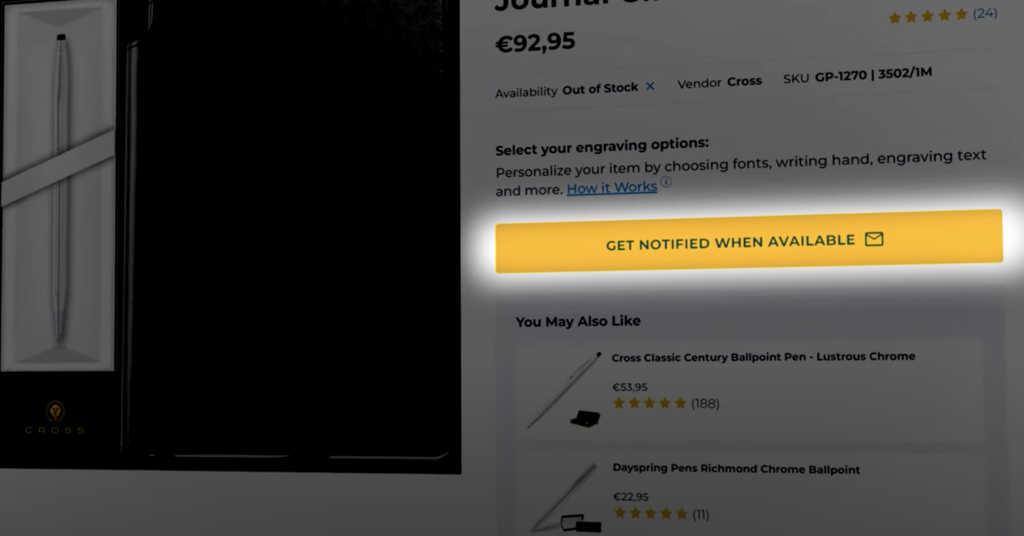IN TODAY’S ISSUE:
- 🎯 New study indicates Google favors eCommerce sites over content sites
- 🚀 Keep your website compliant with the Google June 2024 Spam Update
- 🔎 Google responds to the Google leak, and confirms a few ranking factors
- 📝 Utilize content mapping to create content that actually drives revenue
- 📦 Manage out of stock product pages for improved site rankings
💡 Tip Of The Month
Having just 150-300 words of content can have a big impact on rankings. Here’s the right way to add content to your category pages 👇
DO ✅
→ Aim for 150 – 300 words.
→ Mention your main keyword at least once.
→ Incorporate related keywords.
→ Answer any questions a potential buy might have before making a purchase.
→ Make the first few sentences visible and put the rest behind a ‘Read more’ link.
DON’T ❌
→ Add too much content on your category pages. Google might view it more as a blog post with “informational” intent than a category page with “transactional intent.
→ Have a large block of content pushing your products below the fold.
→ Add any fluff. It’s better to have 200 words of concise content than 500 words of fluffy content.
→ “Over optimize” your content by stuffing in lots of keywords. Write naturally.
Study: Google Favors eCommerce Sites & User-Generated Content
📝 Read the full article here: https://www.searchenginejournal.com/study-google-favors-ecommerce-sites-user-generated-content/520326/
A study found that Google is now prioritizing eCommerce websites and sites with user-generated content, while decreasing the visibility of product review and affiliate marketing sites. Keywords that previously returned results from product reviews and affiliate sites now predominantly feature online retailers.
Key takeaways 👇
✅ Recent Google updates are favoring eCommerce websites for many transactional head terms (ie. “bird feeders”, “laptops”, and “towel warmers”.
✅ Consider revisiting any popular head terms that used to be too difficult to rank for.
✅ As Google favors user-generated content, consider making product reviews more prominent on your product and category pages.

Google June 2024 Spam Update Takes Target
📝 Read the full article here: https://www.seroundtable.com/google-june-2024-spam-update-37601.html
Google released their June 2024 Spam Update to target and penalize websites violating Google’s spam policies. This article provides insights into the rollout process and the expected duration for the update to take full effect.
Key takeaways 👇
✅ Google specifically mentioned that this update did not target link spam, but instead focused on their other spam policies.
✅ If you were hit by this update, review Google’s spam policies to ensure your website is in compliance.
✅ We speculate that this update likely focused more on the following spam policies since these have been high on Google’s radar in recent months: Google’s Machine-generated traffic, Scaled content abuse, Scraped content.

Google Responds To Specific Search Leak, Navboost, Clicks & User Interactions
📝 Read the full article here: https://www.seroundtable.com/google-search-leak-navboost-clicks-user-interactions-37547.html
In a detailed response to the recent Google leak, Google Search Liaison Danny Sullivan officially responds to the leak and sheds light on the mechanisms driving Google’s search rankings. He clarifies that Google considers a variety of factors, including user engagement, to determine which pages appear first.
Key takeaways 👇
✅ Google admits that in some cases their updates negative impact website that deserve to rank higher: “it’s us in some of these cases, not the sites”.
✅ Google confirms that interaction data (SERP click-through rate, bounce rate, dwell time, etc.) are ranking factors, but they also use a variety of other ranking factors as well.
✅ Focus on building your brand and you’ll receive positive rankings signals as a result (more traffic from diversified sources, more social media shares, more branded search traffic, higher SERP click-through rates, etc.).

Mastering Content Mapping: A Strategic Approach To Boost SEO
📝 Read full article here: https://www.searchenginejournal.com/mastering-content-mapping-a-strategic-approach-to-boost-seo/515864/
Content mapping is the process of aligning content with the specific interests and needs of your target customer at each stage of the buyer’s journey (Awareness, Consideration, Decision). This article outlines how tying your content strategy to your customer personas and buyer’s journey can help improve your SEO performance.
Key takeaways 👇
✅ Don’t sleep on creating customer personas. These can help add the “why” to your blogging efforts and make sure each piece of content has a clear goal instead of just creating content because you think you need to.
✅ Create content for each stage of the buyer’s journey (Awareness, Consideration, Decision), keeping in mind that most conversions and revenue will happen in the “Consideration” and “Decision” stages.
✅ Focus on creating product roundups (Best Gaming Laptops), product comparisons (Dell XPS 15 vs Razer 15), product reviews (Dell XPS Review), and price guides (How much do gaming laptops cost?). These types of topics focus on the “Consideration” and “Decision” stage and should drive more revenue.

Can ‘Out-Of-Stock’ Products Kill Your SEO Rankings?
▶️ Watch the full video here: https://www.youtube.com/watch?v=0gmXkvKpdEw
Out-of-stock product pages can significantly harm your e-commerce site’s SEO by creating poor user experiences, wasting your crawl budget, and causing website bloat. In this video, I’ll show you exactly how you can effectively manage out of stock product pages for improved site rankings.
In this video you’ll learn 👇
✅ For temporarily out of stock pages, allow visitors to input their email address so they can be notified when the product is back in stock.
✅ Don’t redirect high-traffic product pages. Instead, leave it up with a message pointing visitors to a close alternative.
✅ Redirect any low-traffic product pages with backlinks to the closest equivalent page.
✅ It’s okay to let a product page 404 if it doesn’t have any traffic or backlinks. Just make sure to remove any internal links to the page.

Get the latest Google Algorithm updates and eCommerce SEO tips directly to your inbox.
Sign up below for free – opt out anytime!

 by
by 


